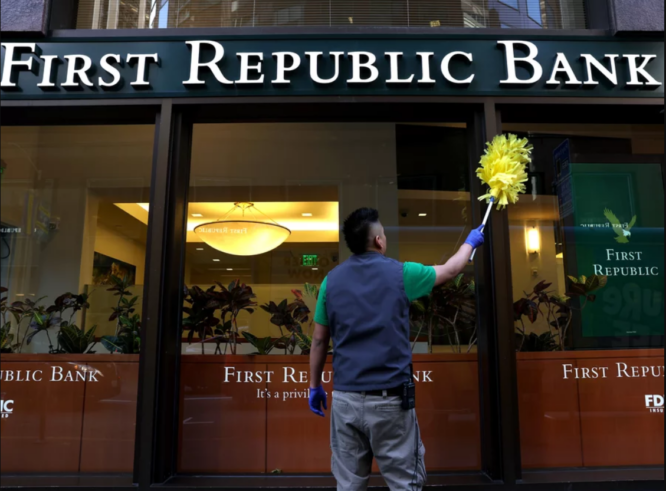It was the third significant U.S. bank failure in less than two months when regulators seized First Republic Bank and sold a substantial portion of its assets to JPMorgan Chase.
The Federal Deposit Insurance Corporation (FDIC) briefly assumed control of First Republic over the weekend before supervising the sale of the bank in what it calls a “highly competitive bidding process.”
JPMorgan announced in a press release that it would acquire First Republic’s deposits as well as “a significant portion of their assets and certain liabilities.”
“Our government invited us and others to step up, and we did,” JPMorgan Chase CEO Jamie Dimon said in a statement. This acquisition is accretive to shareholders, contributes to the advancement of our wealth strategy, and is complementary to our existing brand.
The American economy is losing momentum. Bank difficulties and other obstacles are to blame.
On Monday, 84 First Republic branches became JPMorgan Chase Bank branches, and depositors have unrestricted access to their funds.
First Republic has endured a turbulent week, and its acquisition is the latest event in a period of banking turmoil that has roiled the nation’s financial system.
First Republic has struggled since the U.S. took over Silicon Valley Bank and Signature Bank in March, but its death spiral began in earnest last Monday when it announced that it had lost approximately $100 billion in deposits during the first quarter of the year.

Its stock dropped so drastically last week that the New York Stock Exchange was forced to suspend trading dozens of times. Friday’s closing price was $3.51, a decrease of more than 97% year-to-date.
President Biden welcomed the seizure and sale of First Republic on Monday, stating that it would “ensure the safety of the banking system” and that taxpayers would not be responsible for the rescue.
A downward spiral
First Republic is the largest U.S. lender to fail since the 2008 acquisition of Washington Mutual by JPMorgan Chase.
In March, federal regulators intervened to safeguard the customers of Silicon Valley Bank and Signature Bank, both of which experienced a run on the bank in which depositors rushed to withdraw their funds.
In light of the potential risk to the broader financial system, regulators took unprecedented action to insure all deposits at the two banks, including those in excess of the FDIC’s $250,000 insurance threshold.
The failure of these two lenders prompted the identification of First Republic as an additional lender susceptible to deposit outflows.
The 1985-established bank in San Francisco catered primarily to affluent customers by providing mortgages and business loans.
Eleven of the nation’s largest banks, headed by JPMorgan, deposited $30 billion in March in an effort to boost confidence in First Republic.

Ultimately, these moves failed to persuade Wall Street, and customers continued to withdraw funds.
First Republic had few choices remaining.
First Republic then attempted to sell itself but found few buyers, leaving only a government-led rescue as a viable option.
The FDIC invited several institutions to submit bids, and JPMorgan, the nation’s largest bank, emerged as the winner.
Dimon of JPMorgan noted that the bank’s proposal for First Republic “minimized costs” to the FDIC’s Deposit Insurance Fund.
According to the FDIC, the acquisition and transfer of First Republic will cost the fund approximately $13 billion.
For JPMorgan, the acquisition entails the “assumption of approximately $92 billion in deposits” held by First Republic as well as the purchase of approximately $173 billion in loans and approximately $30 billion in securities.
Banking concerns have diminished.
In contrast to Silicon Valley Bank and Signature, whose failures threatened to ignite additional bank runs, the current situation is more tranquil.
This month’s earnings reports from smaller lenders indicated that deposit outflows have stabilized substantially.
The feared mass exodus did not occur, according to Jared Shaw, a bank analyst at Wells Fargo Securities. Shaw emphasizes that lenders were proactive.
The banks did an excellent job of communicating with their customers, explaining their balance sheets and where their liquidity originates from.
The cost to rescue two failed institutions was $22 billion. The issue now is who will pay
And federal regulators were eager to emphasize that First Republic’s difficulties were not indicative of broader banking industry issues.
“Americans should feel confident in the safety of their deposits and the ability of the banking system to fulfill its essential function of providing credit to businesses and families,” according to a Treasury Department spokesperson.
This sentiment was echoed by Dimon in his comments to reporters after the transaction was announced.
“The system is very, very sound,” he said.
Focus now is on bank regulations
The FDIC’s actions come at a time when regulators are being questioned as to whether they could have prevented the failures of Silicon Valley Bank and Signature Bank.
Friday, the Federal Reserve accepted partial responsibility for the failure of Silicon Valley Bank, stating that the lender should have been subjected to more stringent oversight.
The Federal Reserve also suggested employing a stricter approach to bank regulation, including subjecting more small lenders to increased Fed oversight.
In a scathing report, the Fed acknowledges some responsibility for Silicon Valley Bank’s failure.
Monday, the FDIC released a report outlining potential adjustments to the nation’s deposit system.
According to the FDIC report, providing unlimited deposit insurance would likely be too costly and could encourage banks to engage in reckless behavior.
However, it was discovered that a targeted increase in the insurance limit for certain business accounts could provide benefits, particularly when coupled with other measures such as limits on rapid bank withdrawals.
Any modification to the deposit insurance system requires congressional approval.

